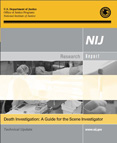|
View in browser: https://www.crime-scene-investigator.net/newsletter/0119.html
|
||
|
JANUARY 2019 | ||
| ||
|
This Month's Featured Resource on the Crime Scene Investigator Network Website
|
||

This revised and updated edition is the result of a collaborative effort to present the most up-to-date information about the issues confronting death investigators today. The death investigator is the eyes and ears of the forensic pathologist at the scene. It is hoped that these guidelines, reflecting the best practices of the forensic community, will serve as a national standard. |
||
|
New CSI and Forensic Job Announcements
|
||
|
The most comprehensive listing of Crime Scene Investigation and Forensic To be notified of job openings as they are posted, follow us on Twitter: Job Posting Alerts |
||
|
Criminalist
Adams County Sheriff's Office, Commerce City, Colorado, USA Final Filing Date: January 24, 2019 The Criminalist assigned to the Laboratory Unit is responsible for responding to crime scenes to collect, preserve, and document evidence, and to evaluate, examine, analyze and identify evidence collected. (physical evidence, photographs, video, sketches, documentation) <View complete job listing> |
||
|
Crime Scene Specialist
Austin Police Department, Austin, Texas, USA Final Filing Date: January 29, 2019 Responds to crime and accident scenes, evaluates the scene and conducts searches for evidence utilizing disciplines related to crime scene investigation. Measures and/or photographs crime scenes, evidence, etc. Documents, collects, packages, preserves, and processes evidence. Utilizes alternate light sources, chemical and physical processes, scientific methods and equipment for the detection and collection of evidence. <View complete job listing> |
||
|
Investigative Technician I/II
Shasta County Sheriff's Office, Redding, California, USA Final Filing Date: February 15, 2019 Searches for, collects, and preserves evidence at crime scenes for laboratory analysis; photographs crime scenes, suspects, or evidence; takes, compares, and identifies fingerprints. Develops and preserves latent fingerprints; conducts latent identification and analysis with the ULW workstation; collects, preserves, compares, and attempts to identify evidence such as blood, hair, fibers, cloth, wood, paint, and glass fragments. <View complete job listing> |
||
 |
||
|
Forensic Scientist Trainee - Controlled Substances
Virginia Department of Forensic Science, Roanoke, Virginia, USA Final Filing Date: Open until filled The Virginia Department of Forensic Science is seeking an individual to train to perform forensic chemical analyses of suspected controlled substances in the Western Regional Laboratory located in Roanoke. <View complete job listing> |
||
|
Cyber Crimes Technician
Anchorage Police Department, Anchorage, Alaska, USA Final Filing Date: January 28, 2019 Assist Detectives with case development, the retrieval of criminal justice information, and provide limited aspects of clerical support to the unit supervisor and commissioned personnel assigned to the Anchorage Police Department Cyber Crime Unit. Support of technical investigations including analysis and documentation of digital data, evidence handling, research and administrative support, court testimony, and INTERNET safety presentations. <View complete job listing> |
||
|
Forensic Scientist - Latent Print Examiner
DuPage County Sheriff's Office, Wheaton, Illinois, USA Final Filing Date: January 31, 2019 Performs the development (physical and chemical processing), digital photography, analysis, AFIS/NGI searching, comparison, evaluation and verification of known and latent print evidence. Makes conclusions, and formulates opinions based on examinations performed and reports those findings. <View complete job listing> |
||
|
Search for more job listings in Crime Scene Investigations and Forensics To be notified of job openings as they are posted, follow us on Twitter: Job Posting Alerts |
||
|
Other Resources on the Crime Scene Investigator Network Website
|
||
|
Not Subscribed to this Newsletter?
|
||
|
If you are not subscribed to this newsletter, you may subscribe with this link: SUBSCRIBE via email |
||
|
To Unsubscribe
|
||
|
To unsubscribe from future e-mail newsletters, please click here: UNSUBSCRIBE Copyright ©2019 Crime Scene Resources, Inc. Crime Scene Investigator Network |


